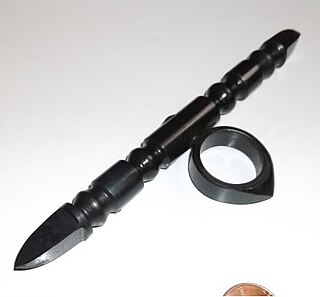 W
WBo hiya is the Japanese version of the fire arrow. Bo-hiya were used in ancient Japan and by the samurai class of feudal Japan.
 W
WThe fukiya (吹き矢) is the Japanese blowgun, as well as the term for the associated sport. It consists of a 1.2-metre-long tube, with darts approximately 20 centimetres (7.9 in) in length. Unlike modern Western blowguns, the fukiya has no mouthpiece: instead, a shooter must maintain a seal with the lips as he or she forcefully exhales. The darts used in the fukiya are called fukibari. Traditionally, fukibari were two inches in length.
 W
WThe kama is a traditional Japanese farming implement similar to a sickle used for reaping crops and also employed as a weapon. It is often included in weapon training segments of martial arts. Sometimes referred to as kai or "double kai," kama made with intentionally dull blades for kata demonstration purposes are referred to as kata kai.
 W
WKubotan is a genericized trademark for a self-defense keychain weapon developed by Sōke Takayuki Kubota in the late 1960s. It is typically no more than 5.5 inches long and about half an inch in diameter, slightly thicker or the same size as a marker pen. The material is usually a hard high-impact plastic such as Lexan. The body of the Kubotan is lined with six round grooves with a screw eye or swivel and split ring attachment at one end for keys.
 W
WA kunai is a Japanese tool thought to be originally derived from the masonry trowel. The two widely recognized variations of the kunai are short kunai and the big kunai. Although a basic tool, in the hands of a martial arts expert, the kunai could be used as a multi-functional weapon. The kunai is commonly associated with the ninja, who used it to gouge holes in walls.
 W
WThe Kunitomo air gun was an air rifle circa 1820, by the Japanese inventor Kunitomo Ikkansai who developed various manufacturing methods for guns and also created an air gun based on the study of Western knowledge ("rangaku") acquired from the Dutch in Dejima.
 W
WThe kyoketsu-shoge , which means "to run about in the fields and mountains", is a double-edged blade, with another curved blade attached near the hilt at a 45–60 degree angle. This is attached to approximately 10 to 18 feet (3–5 m) of rope, chain, or hair which then ends in a large metal ring. Likely used by ninja of the Iga province, it is thought to be a forerunner to the later more widely known kusarigama. Ninja were often recruited from the class of rural peasantry who resided on remote farmland, and the tool's resemblance to farming equipment and high versatility in combat gave it many benefits in stealth combat.
 W
WThe nagamaki is a type of traditionally made Japanese sword (nihontō) with an extra long handle, used by the samurai class of feudal Japan.
 W
WAn ōdzutsu was a type of artillery used during the Sengoku Jidai and the early Edo period in Japan.
 W
WOno or masakari is the Japanese word for "axe", and is used to describe various tools of similar structure. As with axes in other cultures, ono are sometimes employed as weapons. Many existing examples of this particular weapon are associated with the sōhei or yamabushi, who also adapt other agricultural tools as weapons, although samurai are also pictured as using ono in woodblock prints. Ono that were specifically designed for military use are of extreme rarity. The weapon version of the ono is described as having "a very large head with a very convex cutting edge and a large scroll-shaped peen opposite it. It has a sheath covering only the edge of the blade. The entire length is nearly six feet".
 W
WAn ōtsuchi is a large wooden war mallet used by the samurai class of feudal Japan. The ōtsuchi had a shaft of about 6 feet (1.8 m) much like the ono. It was mainly used for door breaching.
 W
WThe sai is a traditional Asian melee weapon used for striking and blocking. It is most famously used in ninjutsu and kobujutsu, but also in southern Chinese martial arts. The basic form of the weapon is that of a sharp metal prong with two curved sideprongs (yoku) projecting from the handle (tsuka). There are many different types of sai with varying prongs for trapping and blocking.
 W
WA shuriken is a Japanese concealed weapon that was used as a hidden dagger or metsubushi to distract or misdirect.
 W
WThe suntetsu (寸鉄) is a Japanese concealed weapon. A suntetsu is a metal rod/spike about 6 inches in length with a ring attached to it. The middle finger is inserted into the ring and the suntetsu rests in the hand by various grips. Suntetsu are small, easy to conceal and relatively simple to learn how to use. Suntetsu are used for stabbing, poking, pinching, striking, smashing, scraping and throwing. Suntetsu can be used alone or as a pair.
 W
WThe yawara is a Japanese weapon used in various martial arts. Numerous types of jujutsu make use of a small rod, made of wood, that extends somewhat from both ends of a person's fist which is known as a yawara. The yawara likely originated from the use of the tokkosho, a Buddhist symbolic object, by monks in feudal Japan. The tokkosho was used during the Edo period and it was made of brass. Sometimes a short rope or cord would be looped around the user's wrist to distract someone else while in combat. The methods of using a yawara may have been created by samurai that used tantojutsu, which was combat that made use of a short knife. According to another theory, a samurai might have fought with the scabbard "when a more deadly weapon was not necessary".
 W
W